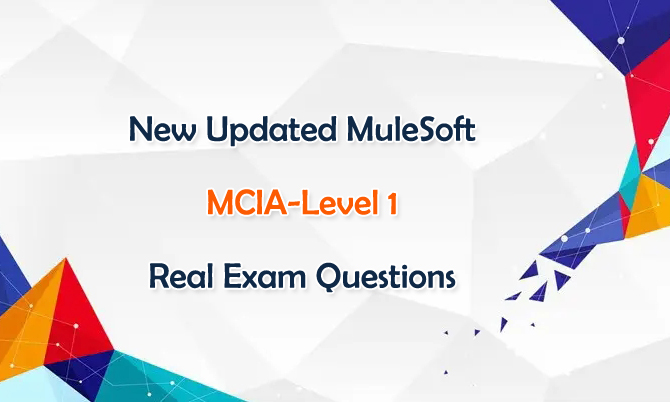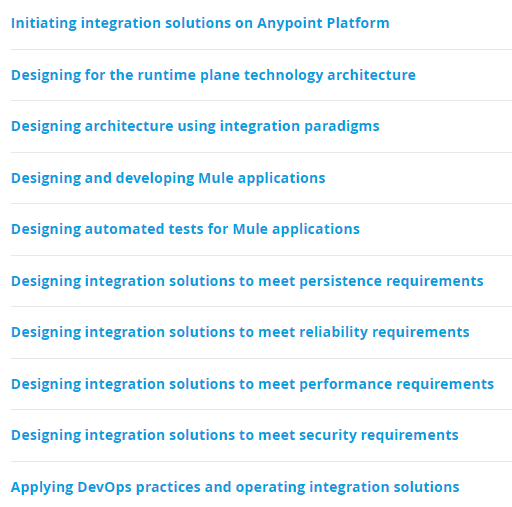MuleSoft MCIA-Level 1 real exam questions have been updated, which are valuable for you to pass MuleSoft Certified Integration Architect - Level 1 MCIA-Level 1 test. The MCIA-Level 1 exam validates that an architect has the required knowledge and skills to work with technical and non-technical stakeholders to translate functional and non-functional requirements into integration interfaces and implementations. MuleSoft MCIA-Level 1 exam related information is helpful in the preparation.
The following are the details of MuleSoft certification MCIA-Level 1 exam topics.
The updated MuleSoft MCIA-Level 1 real exam questions are the best material for you to study the above MuleSoft Certified Integration Architect - Level 1 exam topics. Share some updated MuleSoft MCIA-Level 1 real exam questions and answers below.
1. An organization is designing Mule application which connects to a legacy backend. It has been reported that backend services are not highly available and experience downtime quite often. As an integration architect which of the below approach you would propose to achieve high reliability goals?
A. Alerts can be configured in Mule runtime so that backend team can be communicated when services are down
B. Until Successful scope can be implemented while calling backend API's
C. On Error Continue scope to be used to call in case of error again
D. Create a batch job with all requests being sent to backend using that job as per the availability of backend API's
Answer: B
2. A global, high-volume shopping Mule application is being built and will be deployed to CloudHub. To improve performance, the Mule application uses a Cache scope that maintains cache state in a CloudHub object store. Web clients will access the Mule application over HTTP from all around the world, with peak volume coinciding with business hours in the web client's geographic location. To achieve optimal performance, what Anypoint Platform region should be chosen for the CloudHub object store?
A. Choose the same region as to where the Mule application is deployed
B. Choose the US-West region, the only supported region for CloudHub object stores
C. Choose the geographically closest available region for each web client
D. Choose a region that is the traffic-weighted geographic center of all web clients
Answer: A
3. Insurance organization is planning to deploy Mule application in MuleSoft Hosted runtime plane. As a part of requirement, application should be scalable. highly available. It also has regulatory requirement which demands logs to be retained for at least 2 years. As an Integration Architect what step you will recommend in order to achieve this?
A. It is not possible to store logs for 2 years in CloudHub deployment. External log management system is required.
B. When deploying an application to CloudHub, logs retention period should be selected as 2 years
C. When deploying an application to CloudHub, worker size should be sufficient to store 2 years data
D. Logging strategy should be configured accordingly in log4j file deployed with the application.
Answer: A
4. An organization's governance process requires project teams to get formal approval from all key stakeholders for all new Integration design specifications. An integration Mule application Is being designed that interacts with various backend systems. The Mule application will be created using Anypoint Design Center or Anypoint Studio and will then be deployed to a customer-hosted runtime. What key elements should be included in the integration design specification when requesting approval for this Mule application?
A. SLAs and non-functional requirements to access the backend systems
B. Snapshots of the Mule application's flows, including their error handling
C. A list of current and future consumers of the Mule application and their contact details
D. The credentials to access the backend systems and contact details for the administrator of each system
Answer: A
5. What is true about automating interactions with Anypoint Platform using tools such as Anypoint Platform REST API's, Anypoint CLI or the Mule Maven plugin?
A. By default, the Anypoint CLI and Mule Maven plugin are not included in the Mule runtime
B. Access to Anypoint Platform API;s and Anypoint CLI can be controlled separately thruough the roles and permissions in Anypoint platform, so that specific users can get access to Anypoint CLI while others get access to the platform API's
C. Anypoint Platform API's can only automate interactions with CloudHub while the Mule maven plugin is required for deployment to customer hosted Mule runtimes
D. API policies can be applied to the Anypoint platform API's so that only certain LOS's has access to specific functions
Answer: A

